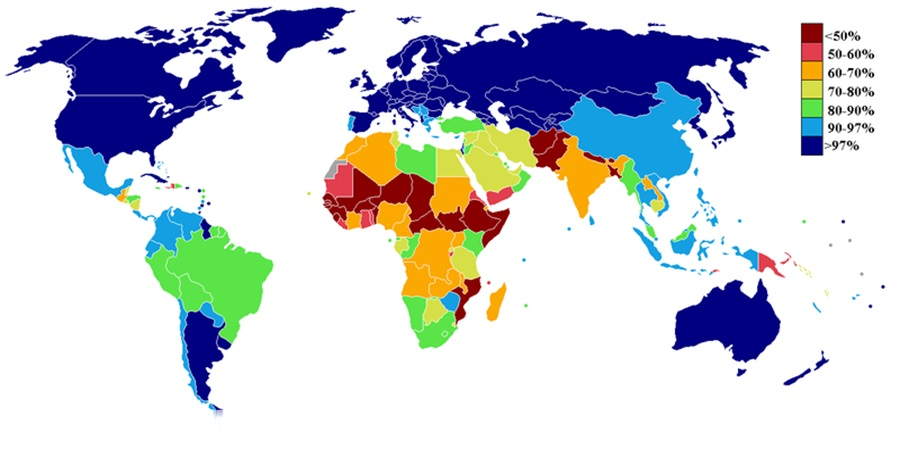
Located between Spain and France, Andorra is a small, independent European nation with a population of approximately 77,000. The principality is well-known for its scenic mountain vistas, ski resorts, and tax-free status. Andorra also has a very high literacy rate, which is a testament to the country’s commitment to education. The literacy rate in Andorra is 100%. The vast majority of Andorran citizens have access to an education, and the country has invested heavily in its education system. The high literacy rate in Andorra can be largely attributed to the country’s commitment to education.
Finland has one of the highest literacy rates in the world, with nearly 100% of the population able to read and write. Education in Finland is highly valued, and the government works hard to ensure that all students receive a quality education. Finland has a long history of literacy, with the first school being established in 1686. Since then, the country has made great strides in improving its literacy rate, which is currently among the highest in the world. The Finnish government places a strong emphasis on literacy education, and provides a range of support services to help students achieve and maintain literacy. These services include providing books and other materials to schools, as well as offering adult education classes. The Finnish education system is based on a comprehensive system of learning, which includes a wide range of subjects, including language, mathematics, science, technology, and foreign languages.
The tiny landlocked nation of Liechtenstein is home to a population of approximately 38,000 people. It is located in the heart of the Alps, between Austria and Switzerland, and is the sixth smallest country in the world. As a small nation, Liechtenstein is often overlooked in terms of international importance, but it is actually a prosperous and advanced nation with a high standard of living. This is in part due to its strong economy, which is largely based on financial services and industry. One of the most impressive aspects of Liechtenstein is its literacy rate. Liechtenstein has an impressive adult literacy rate of 100%. The education system in Liechtenstein is highly regarded and is based on the same principles as other high-income countries. The government supports and funds the education system, which is why the literacy rate is so high.
Luxembourg is a small landlocked country in western Europe, bordered by France, Germany, and Belgium. It is one of the smallest and wealthiest countries in the world, with an area of just 2,586 square kilometers and a population of over 613,000 people. Luxembourg’s literacy rate is 100%. This is largely due to the country’s commitment to education, which is compulsory for children between the ages of 6 and 16 and free of charge. Literacy is also encouraged through the government’s focus on the development of strong public libraries and the promotion of reading and writing in both French and German.
North Korea has a literacy rate of 100%. The education in North Korea is state funded and universal. The education system in North Korea comprises of one year of kindergarten, four years of primary education, six years of secondary education, and thereafter university.
Norway is renowned for its high literacy rate, which is one of the highest in the world. The country has achieved an impressive 100% literacy rate. In addition, nearly all Norwegians speak both Norwegian and English, as the country is officially bilingual. The high literacy rate in Norway is due to a number of factors, including the country’s comprehensive education system. All children in Norway are required to attend school until they reach the age of 16, and all public schools are free of charge. In addition, the Norwegian government invests heavily in literacy initiatives, including the use of libraries, the provision of free books, and the promotion of reading among children. The benefits of a high literacy rate are evident in Norway. Citizens are able to access a range of educational and employment opportunities, while businesses benefit from a highly educated workforce.
As per the latest UNESCO data, Uzbekistan has a liteacy rate of 100%. Uzbekistan has made significant strides in improving its education system, including literacy rates. Uzbekistan has traditionally placed importance on education, and the government has implemented various policies to enhance literacy levels.
Latvia is a small, yet highly developed nation located in the Baltic region of Northern Europe. It is a parliamentary republic with a population of around 1.9 million people. Latvia is a member of the European Union, the United Nations, NATO, and the Eurozone. In terms of literacy rate, Latvia ranks very highly among countries worldwide. According to UNESCP, Latvia’s literacy rate is 99.9%.
Estonia has a high literacy rate of 99.9%, reflecting the country's strong emphasis on education. Estonia has made significant progress in developing its education system since gaining independence in the early 1990s. The literacy rate in Estonia is typically well above the global average, and the country places a high value on providing quality education to its citizens.
Lithuania is situated in the Baltic region of Europe. It regained independence from the Soviet Union in 1990 and joined the European Union in 2004. regained independence from the Soviet Union in 1990 and joined the European Union in 2004. As per the latest data, Lithuania has a literacy rate of 99.83%.